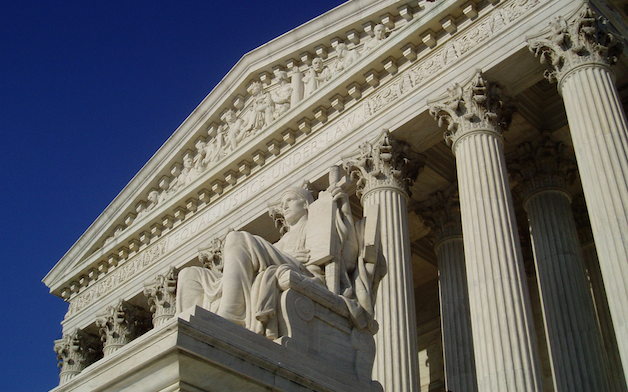Supreme Court opens door to same-sex marriage in more states

"[T]he decision not to take the cases is surprising, particularly because the decision could mean that same-sex marriages will begin in thirty states."
The Supreme Court’s decision to decline to hear the marriage equality cases was quite surprising. Most had believed that they would either take one or more of the cases or, more likely, simply sit on the petitions and wait to see how the other federal appellate courts decided the issue. Instead, they refused to take the cases, which now means that same sex marriages in the relevant states – Utah, Oklahoma, Wisconsin, Indiana, and Virginia – will be allowed in the immediate future. Indeed, the wedding bells have already started to ring in Virginia, where the US Court of Appeals for the Fourth Circuit issued its mandate on the same day the Supreme Court declined to take the case.
Importantly, declining to take the case does not mean that the Supreme Court has endorsed marriage equality. Technically, they have not decided the issue. Supreme Court rules make clear that a decision not to hear a case says nothing about the merits of the case. In the future, the Court could take up the issue of marriage equality and go the other way, concluding that state bans on same-sex marriage do not violate the US Constitution.
The Supreme Court’s decision not to hear these cases is also consistent with its general approach in determining which cases to take. The Supreme Court tends to wait for issues to percolate and typically only intervenes when lower courts are in disagreement on an issue, a “circuit split.” When a circuit split arises, the Supreme Court has confidence that all sides of the issues have been well-vetted and that, when it steps in to resolve the disagreement, the lower courts and litigants will be able to present all sides of an issue. Here, at present, there is no circuit split – all of the federal appellate courts that have decided the issue have concluded that same-sex marriage bans are unconstitutional. The Court may prefer to have a court go the other way so that the reasoning on both sides of the issue has been rigorously explored.
There are additional complications to these cases that may not be apparent to the lay observer. Although the appellate courts have all found these bans unconstitutional, there are differences among the courts about the reasons the bans are unconstitutional. Some have found that, because marriage is a fundamental right, the bans violate the Due Process Clause. Others have rejected the argument that there is a fundamental right to same-sex marriage and instead have invalidated these bans on the grounds of equal protection. There is also some disagreement as to whether sexual orientation should be treated as a “suspect class” akin to race or gender, which would make it more difficult for states to justify bans on same-sex marriage. Finally, some of the cases dealt with whether a state had to recognize a same-sex marriage from outside of the state, as opposed to allowing same-sex marriage within the state. Thus, within this seemingly simple issue, there is a host of complexity which may have lead the Court to delay intervening at this time.
Nevertheless, the decision not to take the cases is surprising, particularly because the decision could mean that same-sex marriages will begin in thirty states. With the exception of one court, the federal appellate courts hear cases based on geography, and their decisions then impact a number of states. For example, the decision by the Fourth Circuit technically only addressed the marriage ban in Virginia. But the Fourth Circuit’s jurisdiction also extends to West Virginia, North Carolina and South Carolina, all of which have marriage bans in place. Although litigants in those states will need to sue to have the bans invalidated, the fact that the Supreme Court declined to take the case means that the Fourth Circuit’s decision will be binding in those other states.
Importantly, by declining to take these cases, the five states whose bans were ruled unconstitutional must allow same-sex couples to marry. That is why the Supreme Court’s refusal to hear the cases is shocking. If the Court, in some future case, decides to address the issue and ultimately comes down the other way, finding same-sex marriage bans constitutional, there will now be thousands of same-sex couples married in states with these bans, and the legal status of their marriages will all be in doubt. The legal status of those marriages would need to be litigated, along with likely issues of adoption and divorce.
Some view the Court’s action today as showing the writing on the wall for marriage bans. If all of the lower appellate courts ultimately agree that such bans are unconstitutional, even if they disagree on why they are unconstitutional, then the Supreme Court may never have to intervene. That may be what the justices are hoping for – to avoid having to wade into this complex social issue. Nevertheless, there are reasons to believe that the time has come for marriage equality in the United States. We thus will need to wait a bit longer to see what the remaining appellate courts do. If one finds the bans constitutional, the Supreme Court will have to take the case to resolve the conflict among the circuit courts of appeal. Only then will we definitively know whether the Supreme Court supports marriage equality.